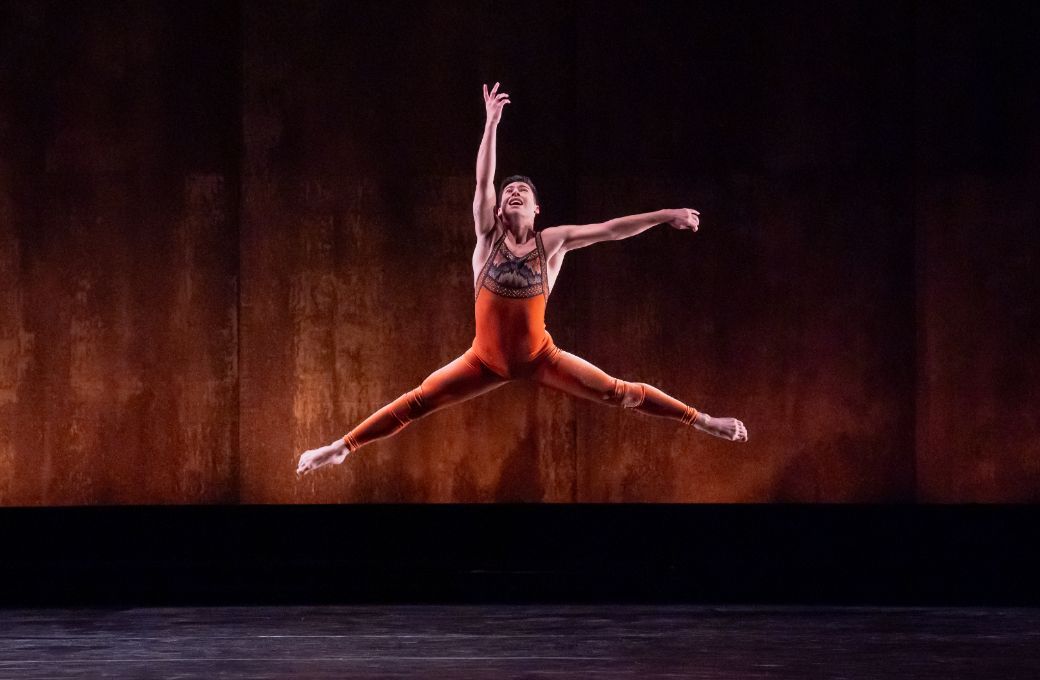Which Paul Taylor dance to serve up to a gala night crowd? With millions of dollars at stake and two wild-card new commissions, make it a perfect one. Sunset fits that bill. Peopled by wistful young soldiers – out of their element, most likely on overseas deployment – and wistful young women who chanced upon one another in a park imagined by artist Alex Katz. Casual sparks flew, of a mostly innocent nature – Taylor was a genius at making innocent sparks fly. But a war hung over their heads (Taylor was also a genius at hanging war over people’s heads).

A reverie unfolded, a little funny, a little tragic, fueled by Elgar and recorded birdsong. Madelyn Ho seemed to drift through the air, skimming over the men’s backs and shoulders with featherweight ease. A tender duet between Lee Duveneck and John Harnage hinted at same-sex attraction. The work is brimful of Taylor-isms: yearning tilts of the upper body, men sailing nonchalantly through the air, hands in their pockets, gestures and glances luminous with intent and stretches of eloquent stillness.
Lauren Lovette’s latest commission could have used stretches of stillness. But she kept it sprinting and drawing poignantly on her personal experience, christened the work stim, alluding to the repetitive movement that helps those with ADHD to calm mind and body. It was refreshing to see dancers onstage physically express anxiety over loud sounds or cold temperatures; we so often think of them as superhuman, impervious to discomfort. The concept was moving but insubstantially realized. The dancers raced in circles. They dashed in from the wings to pop up in the air then dashed off. They engaged in some passive-aggressive hijinks, often involving one dancer grabbing another’s ankle. They channeled Jerome Robbins in crisp turned-in jumps and bounces on their heels, and they channeled Taylor’s Esplanade in baseball slides across the stage.
Elizabeth Chapa set the tone at the start, hinting at a private terror and twisting as if in pain. It was fun to see John Harnage and Devon Louis try to out-jump each other. And Louis and Caleb Mansor do some manly stuff together. Yuniel Betancourt wrapped things up with an expansive, flowy solo and a beatific look on his face. This looked like it belonged in a different ballet.
Lovette’s answer to John Adams’ brassy, synth-laden ‘Fearful Symmetries’ was simply to have the dancers hit the downbeat every time. Despite having an exceptionally versatile and technically commanding ensemble, she revealed little of what they do best and gave them no real stretch.
Robert Battle’s new piece did both. Under the Rhythm takes its title from a poem by Ermira Mitre Kokomani, a meditation on the healing power of jazz. The episodic work is anchored by the African American spiritual ‘Down by the Riverside’, which eventually became a civil rights anthem. The curtain rose on the ensemble of 15 identically clad in white button-downs, black trousers, suspenders, white shoes and bowler hats, standing shoulder to shoulder. The song’s refrain – ‘ain’t gonna study war no more’ – infused with Wycliffe Gordon’s New Orleans-style trombone swagger, set off a sharp semaphore of arms. At one point in the crisply disciplined pattern, repeated over and over, the dancers briefly clutched their throats with both hands. Later, the song resurfaced, soaring on Mahalia Jackson’s gospel exultation and illuminated by Jada Pearson in an exuberant solo, all sparkling footwork and ecstatic arms.
The piece served to situate the origins of American music and dance in the African American experience. Under the Rhythm is fundamentally a work about forms, about the birth of American rhythms from the struggle for freedom and dignity.
Those rhythms coursed furiously through the dancers’ bodies in a kind of marriage of Philadelphia street, jazz and ballet to Gordon’s ‘One O’Clock Jump’, a witty, bluesy, swinging salute to Count Basie. An ebullient Payton Primer rocketed through turns and jumps while Alex Clayton bounced in and out of splits.
A bare-chested Patrick Gamble, oscillating between fear and resolve, was riveting in a solo to the poem read by Battle and his cousin and cast against the stark pulse of Steve Reich’s ‘Clapping Music’, influenced by West African drumming techniques.
Gordon’s pensive trombone rendering of ‘The Lord’s Prayer’ underscored a passionate exchange between Devon Louis and Jessica Ferretti. He tipped forward, her body draped into a backbend around his waist, then abruptly hoisted her overhead in a dramatic arch.
Alex Clayton and Lee Duveneck in lipstick-red tails were swept up in the audacious machine-gun scat of Ella Fitzgerald’s ‘Airmail Special’. They reacted to every syllable, and every random lyric Fitzgerald threw into the mix, clinging to her phrasing as if they were riding pillion while she took the Amalfi Coast’s cliffside hairpins at breakneck speed. It was virtuosic and very funny.


